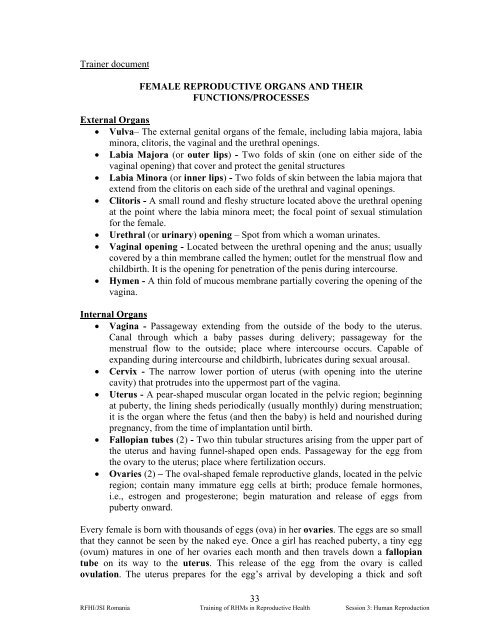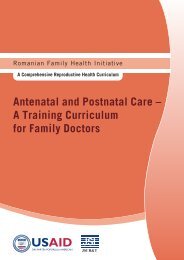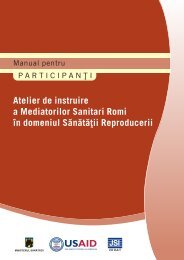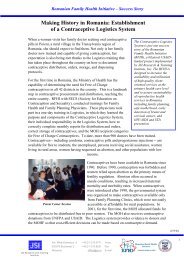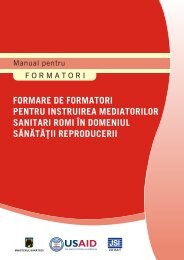Training of Roma Health Mediators in Reproductive Health
Training of Roma Health Mediators in Reproductive Health
Training of Roma Health Mediators in Reproductive Health
Create successful ePaper yourself
Turn your PDF publications into a flip-book with our unique Google optimized e-Paper software.
Tra<strong>in</strong>er document<br />
FEMALE REPRODUCTIVE ORGANS AND THEIR<br />
FUNCTIONS/PROCESSES<br />
External Organs<br />
• Vulva– The external genital organs <strong>of</strong> the female, <strong>in</strong>clud<strong>in</strong>g labia majora, labia<br />
m<strong>in</strong>ora, clitoris, the vag<strong>in</strong>al and the urethral open<strong>in</strong>gs.<br />
• Labia Majora (or outer lips) - Two folds <strong>of</strong> sk<strong>in</strong> (one on either side <strong>of</strong> the<br />
vag<strong>in</strong>al open<strong>in</strong>g) that cover and protect the genital structures<br />
• Labia M<strong>in</strong>ora (or <strong>in</strong>ner lips) - Two folds <strong>of</strong> sk<strong>in</strong> between the labia majora that<br />
extend from the clitoris on each side <strong>of</strong> the urethral and vag<strong>in</strong>al open<strong>in</strong>gs.<br />
• Clitoris - A small round and fleshy structure located above the urethral open<strong>in</strong>g<br />
at the po<strong>in</strong>t where the labia m<strong>in</strong>ora meet; the focal po<strong>in</strong>t <strong>of</strong> sexual stimulation<br />
for the female.<br />
• Urethral (or ur<strong>in</strong>ary) open<strong>in</strong>g – Spot from which a woman ur<strong>in</strong>ates.<br />
• Vag<strong>in</strong>al open<strong>in</strong>g - Located between the urethral open<strong>in</strong>g and the anus; usually<br />
covered by a th<strong>in</strong> membrane called the hymen; outlet for the menstrual flow and<br />
childbirth. It is the open<strong>in</strong>g for penetration <strong>of</strong> the penis dur<strong>in</strong>g <strong>in</strong>tercourse.<br />
• Hymen - A th<strong>in</strong> fold <strong>of</strong> mucous membrane partially cover<strong>in</strong>g the open<strong>in</strong>g <strong>of</strong> the<br />
vag<strong>in</strong>a.<br />
Internal Organs<br />
• Vag<strong>in</strong>a - Passageway extend<strong>in</strong>g from the outside <strong>of</strong> the body to the uterus.<br />
Canal through which a baby passes dur<strong>in</strong>g delivery; passageway for the<br />
menstrual flow to the outside; place where <strong>in</strong>tercourse occurs. Capable <strong>of</strong><br />
expand<strong>in</strong>g dur<strong>in</strong>g <strong>in</strong>tercourse and childbirth, lubricates dur<strong>in</strong>g sexual arousal.<br />
• Cervix - The narrow lower portion <strong>of</strong> uterus (with open<strong>in</strong>g <strong>in</strong>to the uter<strong>in</strong>e<br />
cavity) that protrudes <strong>in</strong>to the uppermost part <strong>of</strong> the vag<strong>in</strong>a.<br />
• Uterus - A pear-shaped muscular organ located <strong>in</strong> the pelvic region; beg<strong>in</strong>n<strong>in</strong>g<br />
at puberty, the l<strong>in</strong><strong>in</strong>g sheds periodically (usually monthly) dur<strong>in</strong>g menstruation;<br />
it is the organ where the fetus (and then the baby) is held and nourished dur<strong>in</strong>g<br />
pregnancy, from the time <strong>of</strong> implantation until birth.<br />
• Fallopian tubes (2) - Two th<strong>in</strong> tubular structures aris<strong>in</strong>g from the upper part <strong>of</strong><br />
the uterus and hav<strong>in</strong>g funnel-shaped open ends. Passageway for the egg from<br />
the ovary to the uterus; place where fertilization occurs.<br />
• Ovaries (2) – The oval-shaped female reproductive glands, located <strong>in</strong> the pelvic<br />
region; conta<strong>in</strong> many immature egg cells at birth; produce female hormones,<br />
i.e., estrogen and progesterone; beg<strong>in</strong> maturation and release <strong>of</strong> eggs from<br />
puberty onward.<br />
Every female is born with thousands <strong>of</strong> eggs (ova) <strong>in</strong> her ovaries. The eggs are so small<br />
that they cannot be seen by the naked eye. Once a girl has reached puberty, a t<strong>in</strong>y egg<br />
(ovum) matures <strong>in</strong> one <strong>of</strong> her ovaries each month and then travels down a fallopian<br />
tube on its way to the uterus. This release <strong>of</strong> the egg from the ovary is called<br />
ovulation. The uterus prepares for the egg’s arrival by develop<strong>in</strong>g a thick and s<strong>of</strong>t<br />
33<br />
RFHI/JSI <strong>Roma</strong>nia <strong>Tra<strong>in</strong><strong>in</strong>g</strong> <strong>of</strong> RHMs <strong>in</strong> <strong>Reproductive</strong> <strong>Health</strong> Session 3: Human Reproduction


